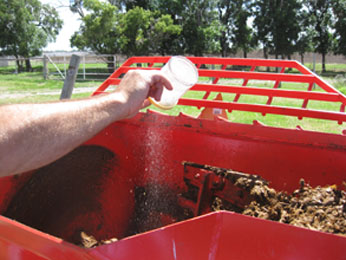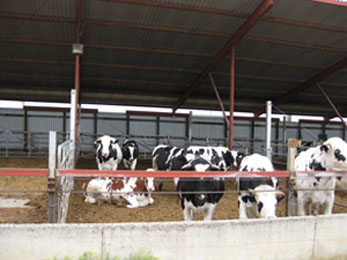Soil Science Society of America
5585 Guilford Road • Madison, WI 53711-5801 • 608-273-8080 • Fax 608-273-2021
www.soils.org
Twitter | Facebook
NEWS RELEASE
Contact: Hanna Jeske, Associate Director of Marketing and Brand Strategy, 608-268-3972, hjeske@sciencesocieties.org
From broken to teaming with life
May 11, 2016 - The old adage, “If it ain't broke, don't fix it,” only works if the “it” isn’t broken. In the case of agricultural practices in Brazil, Cristiano Magalhães Pariz realized something was broken.
“About 15 years ago, our research group began to see that crop and livestock activities, when wrongly conducted, were compromising the sustainability of a tropical agricultural system,” Pariz explained.
 Over time, crop and livestock activities had degraded the soil. The soil had fewer nutrients and was eroding away. It couldn’t produce as large of crops or sustain as many animals. This meant farmers weren’t making as much food or as much money. So Pariz began researching a way to fix the problems caused by these broken crop and livestock practices.
Over time, crop and livestock activities had degraded the soil. The soil had fewer nutrients and was eroding away. It couldn’t produce as large of crops or sustain as many animals. This meant farmers weren’t making as much food or as much money. So Pariz began researching a way to fix the problems caused by these broken crop and livestock practices.
Pariz, a researcher in the Department of Animal Nutrition and Breeding at Sao Paulo State University, Brazil, knew that solving these problems would take a team effort. So he and researchers from different fields of study developed a solution. Their solution also required teamwork -- from plants.
The teamwork they explored between plants is called intercropping. Intercropping is the practice of growing two crops together in the same field. Pariz’s plant team consisted of sorghum and perennial grasses.
In places like the Brazilian Cerrado, winters are very dry. Pariz needed to pick plants for the team that could handle the conditions but also be useful to the farmers. Sorghum, which tolerates dry conditions and is sold for grain, fit the description. Pariz then selected two types of perennial grasses to team up with sorghum. Farmers can use the grasses as forage for livestock and cover the soil surface to prevent erosion. However, the researchers weren’t sure which grass would work best with the sorghum. Researchers set up an experiment to determine which crop team worked together best: Team A (sorghum and palisadegrass) or Team B (sorghum and guineagrass).
The researchers planted crops of Team A and Team B in Botucatu, São Paulo, Brazil. They analyzed the leaf nutrient concentration and the land-use efficiency. They calculated each team’s sorghum grain yield and forage dry matter production. They determined the crude protein and revenue produced. Finally, they looked at how the teammates competed for nutrients, which is very important in intercropping systems.
 Pariz explains, “Competition for nitrogen may occur, which may compromise the sorghum and/or forage yield.” Nitrogen is often added to soil to help plants grow, but no one knows exactly how much nitrogen is needed to make sure both crops can develop and produce. So another aspect of the experiment was to apply different amounts of nitrogen to rows of the crops to see what amount worked best for both the sorghum and its grass teammate.
Pariz explains, “Competition for nitrogen may occur, which may compromise the sorghum and/or forage yield.” Nitrogen is often added to soil to help plants grow, but no one knows exactly how much nitrogen is needed to make sure both crops can develop and produce. So another aspect of the experiment was to apply different amounts of nitrogen to rows of the crops to see what amount worked best for both the sorghum and its grass teammate.
It turns out sorghum is an excellent choice for an intercropping team. It adds diversity to the farm and grows better than other crops in areas with unhealthy soil or dry conditions. The researchers also discovered Team A (sorghum with palisadegrass) with added nitrogen is the best combination for increasing sorghum grain yield, revenue, and forage dry matter production.
With this team of sorghum and palisadegrass and just the right amount of nitrogen, Pariz hopes to reverse the damage that had been done by broken crop and livestock activities. In time, the teamwork of these plants could help Brazil’s degraded pastures team with life.
Read more about Pariz’s work in Agronomy Journal. The authors would like to thank the São Paulo Research Foundation (FAPESP) for financial support and the National Council for Scientific and Technological Development (CNPq) for an award for excellence in research to the second and fifth authors.
Agronomy Journal is the flagship journal of the American Society of Agronomy. Articles convey original research in agriculture, natural resources, soil science, crop science, agroclimatology, agronomic modeling, production agriculture, and instrumentation.